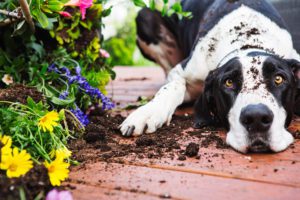8 Common Plants Poisonous to Dogs in Cooper City, FL
Indoor gardening is becoming very popular now, especially in houseplants. Did you know, though, that there are common plants that are poisonous to dogs? These common plants are found everywhere and don’t cause us any symptoms. However, if your dog suffers from plant poisoning, it may suffer from vomiting, lack of energy, exhaustion, and more.
It is important to know and spot poisonous plants as they can save your dog’s life! Just because the plant is toxic, though, does not mean you have to get rid of it. Your plants should be out of reach, though.
Listed below are eight of the most common plants poisonous to dogs.

1. Tomato Plants
It may surprise you to know that tomato plants are one of the deadliest plants to animals like cats and dogs. Don’t panic though, the fruits and flowers produced by tomato plants are not the culprits. Many dogs can eat tomatoes as a snack that is rich in nutrients and vitamins.
The most dangerous part of the tomato plant is the leaves. These delicious-smelling leaves, when consumed, are toxic. They contain a chemical also found in the stems that can cause detrimental effects leading to strokes and seizures.
If you suspect that your dog has taken a bite out of your tomato plant, take them to emergency care as soon as possible.
2. Aloe Vera
While we may know Aloe Vera as a healing plant that brings stomach relief, if your dog eats this plant raw, it can harm their stomachs. This succulent contains a gel-like substance stored inside its leaves that is used as a topical treatment for skin conditions and burns. While this is the case, the outer leaves should never be consumed.
Not only are the leaves moderately toxic and cause severe diarrhea and vomiting, but the outside has spikes that can hurt your dog’s mouth. It is best to place your Aloe Vera plant in a high space out of reach from your dog.
3. Tulips
Tulips are such beautiful and bright spring flowers that it is hard to imagine they are toxic to dogs. However, you should refrain from leaving these spring flowers in your home as they are very toxic.
The most toxic parts of this plant are the leaves and the bulb growing in the ground. If your dog is a digger, you may want to omit this flower from your garden as they can suffer from dehydration, rapid weight loss, and canine depression.
4. Sago Palm
Sago palm is notorious for being highly dangerous and toxic to dogs. This gorgeous palm tree is similar to a regular palm tree and rarely grown inside. Dogs typically don’t pay attention to these plants as they are unappealing, however, if the leaves or bark are consumed it can be fatal.
Nearly all dogs that consume Sago Palm feel symptoms like vomiting, liver pain, liver failure, trouble breathing, and exhaustion. The poisonous effects work quickly in this plant.
5. Ivy
Ivy is another common plant found travelling inside and outside of a home. The large leaves are beautiful and are safe for humans, but detrimental to dogs. The toxin in the ivy leaves typically don’t attract a dog’s attention, but if a dog does consume the leaves they can suffer from confusion, depression, abdominal pain, and anxiety.
If the symptoms worsen, it can be fatal. You should contact your veterinarian if you suspect your dog has consumed Ivy.
6. Jade Plant
The Jade plant is a fun houseplant with rubber-like leaves filled with water. This succulent plant needs little care and is adored by indoor gardeners. Although the toxicity levels of the plant are low, you should avoid placing it in easy to reach locations.
While it rarely causes severe symptoms, your dog can still develop dry heaving, nausea, and abdominal pain from ingesting it.
7. Golden Pothos
The Golden Pothos is a unique plant that needs little to no sun or extra care. It’s bright green and yellow leaves, however, can cause harmful effects on your dogs if consumed. The entire plant is toxic and should be placed in a hard to reach spot.
This plant mildly affects your dogs but is one of the only plants that can cause a skin reaction alongside a gut reaction. Your dog may feel tingling and redness on their gums and lips from chewing on the leaves. These feelings can lead to nausea and abdominal pain.
8. Onion Plants
Possibly the most dangerous plant on this list is the onion plant. This includes large onion bulbs, garlic, and leeks. The roots, bulbs, and leaves are extremely toxic and can cause stomach problems that lead to further complications.
Onions are so toxic that you can’t serve your dog any food with onion powder, cooked onions, or with an onion flavor. Usually, dogs stay away from the strong aroma, but if your dog gets curious you need to take them to a veterinarian immediately as onions can cause stomach ulcers.
Conclusion
In conclusion, it is important that we know and understand which plants can harm our dogs. Not all dogs have the restraint not to eat something new and unfamiliar. This is why plants like aloe vera, onions, and tomato leaves should be placed in a hard to reach area. If your dog consumed any of these plants call Embassy Lakes Animal Hospital at (954) 432-5811 or your emergency vet clinic.
Share This Article
Related Articles
About Embassy Lakes Animal Hospital
Located in Cooper City, FL, we strive to do more than simply be a full-service veterinarian for your pet. Our decades of experience has served generations of families and their beloved pets and we look forward to serving you as well!



